Pentax Q Review
Construction and Handling
The Q is built around a sturdy magnesium alloy body clad with soft and grippable leatherette on the front. The build quality and finish is top notch and confidence inspiring.

Sensor
The Q features a 12.4 megapixels 1/2.3 inch backlit CMOS image sensor. The color depth is 12 bit in DNG RAW mode and 8 bit in JPG mode. This is the first application of a backlit sensor by Pentax. Pentax claims exceptional low noise at high levels of sensitivity despite the small size of the sensor thanks to this new sensor technology. The entire surface of a back-lit sensor is sensitive to light whereas a good part of the surface of a traditional sensor is covered by a mask of wires which shield for the light.
The effective size of the sensor is 6.17 x 4.55 mm which gives a "crop factor" of 5.6. In other words, a 10 mm lens on the Q has the same field of view as a 56 mm lens on a 24 x 36 mm (full-frame) camera. The sensor has an area that is 8 times smaller that of the Olympus E-PL3 and 13 times smaller that of an APS-C sized sensor like in a Pentax K-r/K-5.

The Q has Pentax' in-body shake reduction, where the sensor is mounted on a plate which floats in a magnetic field. It works well also on the Q. The camera reads the focal length of the lens and adjusts the shake reduction movement accordingly. This works with all five Q lenses, including the "toy lenses".
The sensor is shielded by a glass filter which is easy to get to and clean for dust if need be.
Size, Grip and Handling
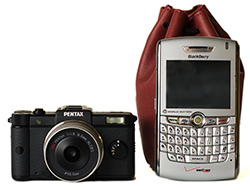 The Q is tiny. It can be difficult to comprehend how small the Pentax Q is unless you see it side by side with some familiar objects. So here you have the Q with its standard prime lens next to a smart phone leaning against an FA 31m
The Q is tiny. It can be difficult to comprehend how small the Pentax Q is unless you see it side by side with some familiar objects. So here you have the Q with its standard prime lens next to a smart phone leaning against an FA 31m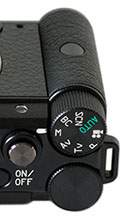 m Limited lens pouch! Yes, the Q with lens would fit in the lens pouch with room to spare!
m Limited lens pouch! Yes, the Q with lens would fit in the lens pouch with room to spare!
Despite its small size the Q handles well thanks to the grip and to the non-slip surface on the front. For additional purchase there is a rough area on the back for the thumb. With these features you never feel that the camera will slip away from you.
At the top of the grip we find the exposure mode dial and command wheel, both of metal and nicely designed into the contours of the grip. The dials are placed so they are easy to operate with your right hand thumb and index finger and has just the right amount of resistance between the click stops.
Lens Mount and Shutter
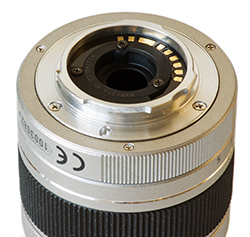 The lens mount is all electronic, there is no mechanical linkage. The body mount is metal and so is the mount on the 01 Standard Prime and the 02 Standard Zoom. The mounts on the other three lenses are made of plastic. Since the lenses are ultra light we don't see it as a negative that these lenses have a plastic mount.
The lens mount is all electronic, there is no mechanical linkage. The body mount is metal and so is the mount on the 01 Standard Prime and the 02 Standard Zoom. The mounts on the other three lenses are made of plastic. Since the lenses are ultra light we don't see it as a negative that these lenses have a plastic mount.
The electrical contacts control auto focus, aperture, the ND filter and the leaf shutter of the 01 and 02 lenses. The camera can read the lens type and focal length through the contacts. Exposure was even across the aperture range so this electronic linkage is very accurate. Similarly we got very even exposure from the leaf shutter across its range.
There is no mechanical shutter in body. If you don't use the leaf shutter in the lens (or if the lens doesn't have a leaf shutter), an electronic shutter comes into play. The electronic shutter is basically a timer that controls the interval where the data from the sensor is captured during exposure. There is no flickering or darkening of the LCD monitor during exposure. Which shutter to use is set in the custom function menu.
The lens mount is a bayonet mount and users of Pentax K DSLRs will feel at home with the lens release button in the usual place.
Viewfinder and LCD Monitor
The Q has no viewfinder so you have to use the LCD monitor on the back for composing your image like on many a point and shoot camera. This is the biggest drawback of the Q in our opinion. The three inch LCD monitor is bright and contrasty all right and has a great resolution of more than 450,000 pixels, but in bright light is quite difficult to frame a picture accurately and it is flat out impossible to focus manually - with three of the five lenses available being manual focus this is most unfortunate. Even turning up the brightness doesn't help since the LCD monitor acts like a mirror and what you see under these conditions is yourself! In dim sunlight, cloudy weather and indoors there is no problem at all.
 There is an optional optical viewfinder available (O-VF1) which attaches to the hot shoe but it only matches the "01" Standard Prime lens and it is ridiculously expensive (about $250). This camera deserves an electronic viewfinder. Without a viewfinder we hesitate to classify the Q as a serious alternative to a DSLR camera or as a viable backup camera.
There is an optional optical viewfinder available (O-VF1) which attaches to the hot shoe but it only matches the "01" Standard Prime lens and it is ridiculously expensive (about $250). This camera deserves an electronic viewfinder. Without a viewfinder we hesitate to classify the Q as a serious alternative to a DSLR camera or as a viable backup camera.
 On the positive side the menus and the control panel has big and clear letters and icons so even in bright light it is actually possible to change settings using the LCD monitor.
On the positive side the menus and the control panel has big and clear letters and icons so even in bright light it is actually possible to change settings using the LCD monitor.
Indoors and in shade the images are rendered beautifully on the monitor making it a real pleasure to review images. The monitor is fixed but is viewable from wide angles and we didn't miss the lack of a tilt/swivel monitor. A tilting electronic viewfinder would be more relevant.
SD Card and Battery
The Q takes all three types of SD cards, SD, SDHC and SDXC. We used a Transcend 32GB class 10 card during our tests. It is inexpensive and it worked flawlessly.
The included rechargeable lithium-ion battery is rated at 1000mAh. We found the battery life on the short side. Pentax specifies that the battery life will last for 250 shots under "standard conditions". We were not able to get that many shots and we recommend that you be prepared to purchase one or two spare batteries.
The access doors are placed on each side of the camera, are solidly made and easy to open. The SD card door opens at a big angle so that it is easy to pop the card out.
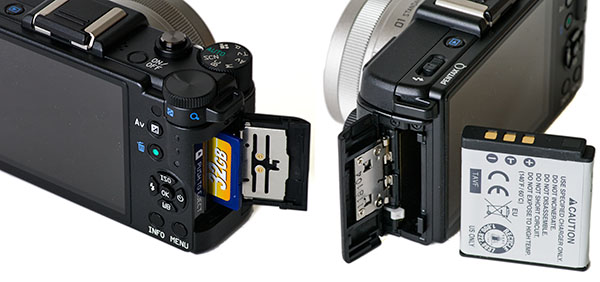
Tripod Socket and Electrical Connections
 The tripod socket is aligned with the optical axis and made of metal so you don't risk to strip the threads. Since the doors for the SD card and battery are located on the sides of the camera you can change card and battery without removing the camera from the tripod, a big plus.
The tripod socket is aligned with the optical axis and made of metal so you don't risk to strip the threads. Since the doors for the SD card and battery are located on the sides of the camera you can change card and battery without removing the camera from the tripod, a big plus.
The electrical connections (USB, HDMI, and AC power) are located below a rubber cover next to the tripod socket so those connections are unavailable on a tripod. We don't consider that an issue since these connections are meant to be used when playing back images or movies only.
Button Layout
All buttons and dials essential for shooting are on the right hand side within easy reach of the thumb and index finger. The flash pop-up button, the play back button, and the Quick Dial are located on the left hand side. Despite the small size of the camera the buttons and dials are easy to use except for the ISO button. Due to the proximity of the grip for the thumb the ISO button is best operated by a finger nail. Unlike a traditional point and shoot camera there is no zoom lever on the camera body. The zoom lens has an amply sized zoom ring instead like on a DSLR camera. The buttons have a nice tactile feel to them giving a clear feed back when activated.

Flash
The Q has a built in flash as well as a standard hot shoe compatible with Pentax' line of flashes and extension cords. With the 02 Standard Zoom and a flash with a zoom head (AF360FGZ and AF540FGZ) the flash will adapt the angle of light output to the focal length set on the lens.
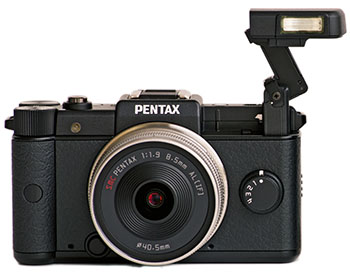 The built in flash can be popped up so as to get farther away from the optical axis of the lens. This should reduce the red-eye effect and prevents that the zoom lens with lens hood casts a shadow on the subject.
The built in flash can be popped up so as to get farther away from the optical axis of the lens. This should reduce the red-eye effect and prevents that the zoom lens with lens hood casts a shadow on the subject.
The flash can also be used retracted. The flash extension mechanism is sturdy and built to last.
The flash can be set to always fire, to fire only when needed, or to never fire. Red-eye reduction, slow speed synchronization, rear curtain synchronization, and flash exposure compensation are also available.
Pentax Q vs. Olympus E-PL3
Handling: The body of the Olympus looks very nice with its smooth front surface manufactured of metal. Unfortunately, while it looks good it is not functional. The surface is slippery and due to the lack of a grip you have the feeling that the camera will slip away from you each time you pick it up. Only a tiny rough area on the back where you rest your thumb provides a bit of purchase.
The Pentax Q with its grip on the front handles much better despite being smaller than the Olympus.
The lens cap on the Olympus kit lens is thin and difficult to remove. The Pentax kit and zoom lenses have lens caps of regular size and they are easy to remove.
Viewfinder: While neither camera has a built-in viewfinder, three different electronic viewfinders are available for the Olympus. The electronic viewfinders shows 100% of the frame and attach to the hot shoe. They even have a tilt function so that they are easy to use also when the camera is close to the ground. An optical viewfinder is available for the Pentax but it only works with the 01 prime lens.
Although both cameras have a rather bright rear LCD, using it in lieu of a viewfinder in the strong Arizona sun proved difficult. Changing settings in bright light was frustrating with the Olympus due to the tiny letters in and poor layout of the menus which are flat out impossible to read in bright light. Even changing aperture in Av mode is hard in bright light and made even worse by the lack of a control wheel. The Pentax Q fares much better thanks to its control panel with big clear letters and its convenient control wheel (e-dial in Pentax terminology).



